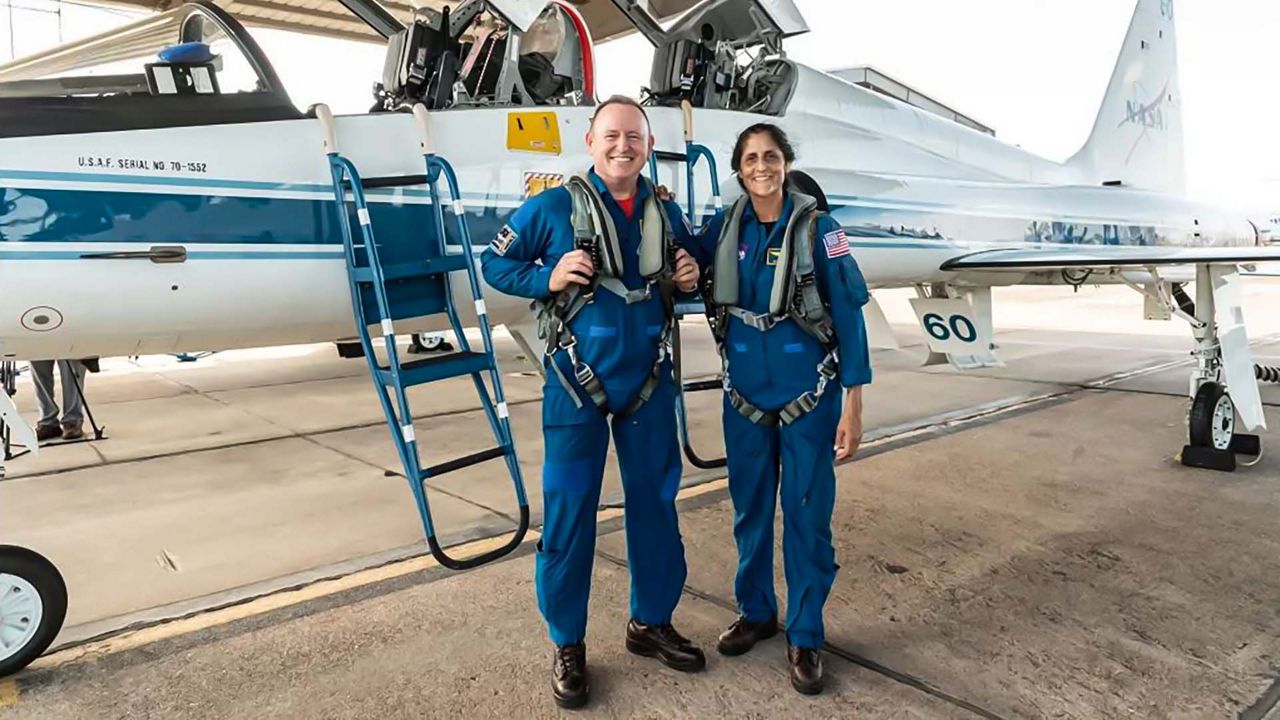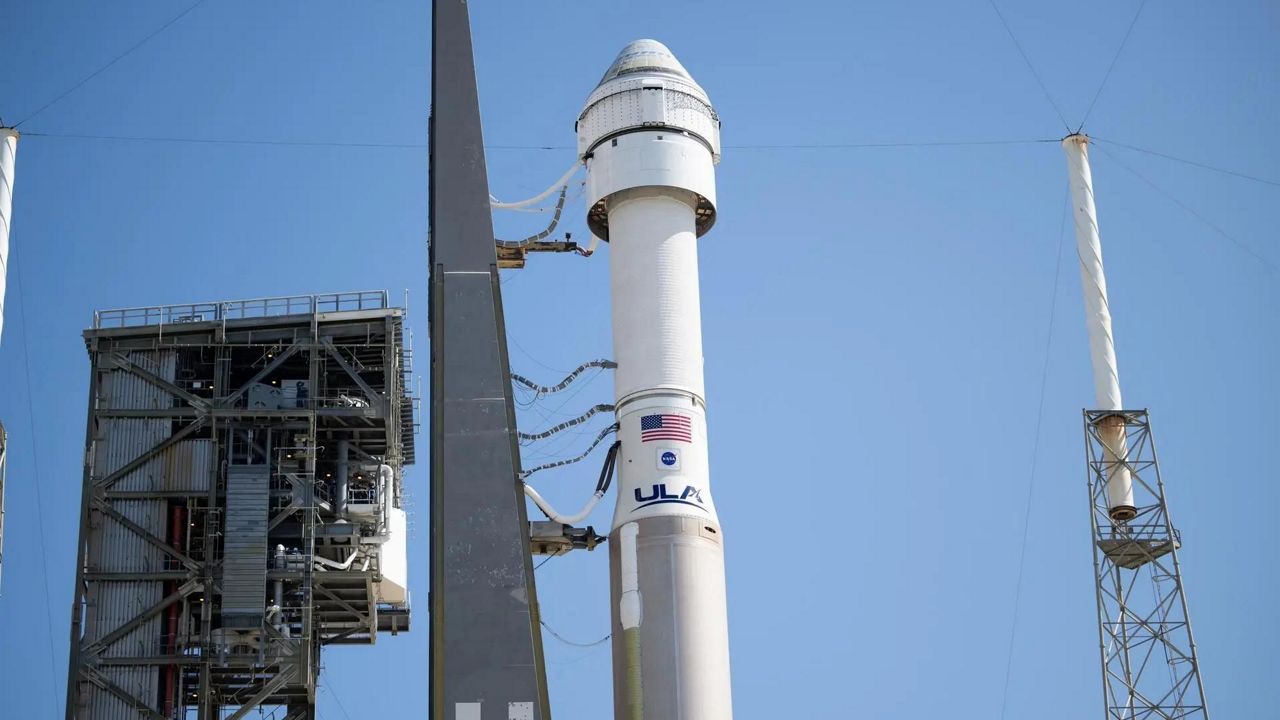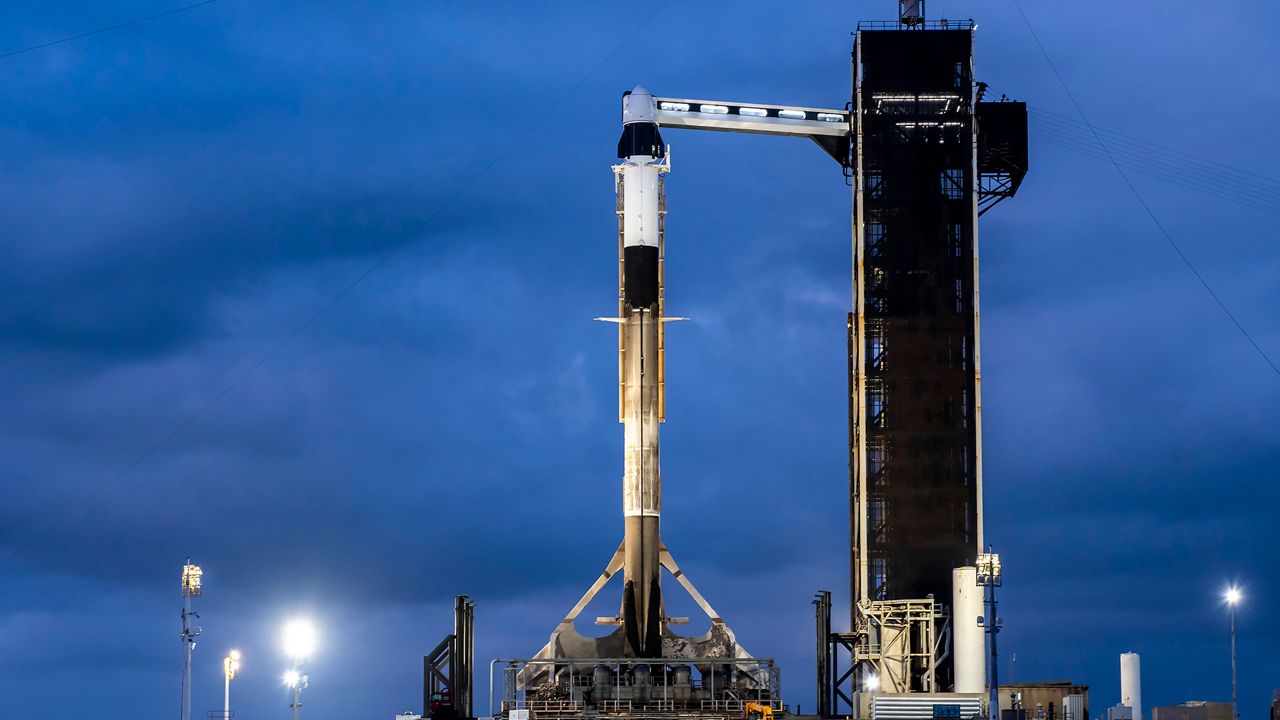CAPE CANAVERAL SPACE FORCE STATION — A day after scrubbing the maiden crewed launch attempt of Boeing's Starliner, NASA announced on Sunday the mission has a confirmed new liftoff date.
What You Need To Know
- The next available launch chance is Wednesday, June 5; backup Thursday, June 6
- In latest press conference, NASA officials explain to Spectrum News why they will fly the Starliner with the helium leak
- RELATED coverage: NASA: Crewed Starliner will launch with helium leak
- Get more space coverage here ▶
- 🔻Scroll down to watch the launch🔻
NASA stated that the new launch date is Wednesday, June 5, with an instantaneous launch at 10:52 a.m. ET.
The 45th Weather Squadron is giving a 90% chance of good conditions for launch, with the only concerns being the cumulus cloud rule.
The second launch attempt scrubbed
Minutes before launch of the crewed Starliner spacecraft on Saturday, June 1, Boeing and NASA scrubbed the mission, with an official from the U.S. space agency stating a computer put a hold. The hold happened at 3 minutes, 50 seconds before the instantaneous liftoff at 12:25 p.m. ET.
"NASA, Boeing, and ULA (United Launch Alliance) scrubbed today’s launch opportunity due to the computer ground launch sequencer not loading into the correct operational configuration after proceeding into terminal count," stated NASA.
On Sunday, the U.S. space agency stated United Launch Alliance’s team discovered the cause.
“The ULA team identified an issue with a single ground power supply within one of the three redundant chassis that provides power to a subset of computer cards controlling various system functions, including the card responsible for the stable replenishment topping valves for the Centaur upper stage,” according to NASA.
The Centaur upper stage is part of ULA’s Atlas V rocket. The chassis are needed to enter the terminal phase of the launch countdown to make sure the crew is safe.
The chassis with the defective ground unit was replaced with a spare one which has been tested and it is working, stated both ULA and NASA in a joint statement.
Early Saturday afternoon, NASA stated the next launch attempt would be Sunday, June 02, at 12:03 p.m. ET. But come Saturday evening, NASA stated the mission team wanted more time to assess the ground support equipment issue and the “next available launch opportunities are Wednesday, June 5, and Thursday, June 6,” it stated.
NASA stated the focus for the launch team is to make sure the ULA Atlas V rocket is in a good configuration as well as Starliner, which is christened Calypso.
For the second time in less than a month, NASA astronauts Cmdr. Barry “Butch” Wilmore and pilot Sunita “Suni” Williams found themselves hoping to be sent to the International Space Station, only to be removed from Boeing’s Starliner spacecraft from Space Launch Complex-41 at Cape Canaveral Space Force Station in Florida.
A number of things were going against this mission, but for Saturday’s attempt, the launch team had to troubleshoot a problem with the topping the Atlas’ Centaur's cryogenic tanks with fuel. Eventually, a workaround was found.
This is a different issue that what originally scrubbed the mission on Monday, May 6. (Scroll down below for more details.)
Before that, the wind conditions gave some a wary eye.
The 45th Weather Squadron gave a 90% chance of good launch conditions, with the only concerns being ground winds and the cumulus cloud rule.
Mark Burger of the squadron explained to Spectrum News what Saturday’s liftoff conditions were like for both the launch day and for Sunday, one of the backup attempts.
Mark Burger of the 45th Weather Squadron was explaining to me the liftoff conditions for @BoeingSpace’s #Starliner mission for today and the backup launch tomorrow.
— 🚀Anthony Leone🌕 (@AnthonyLeone) June 1, 2024
Learn more about the mission at @MyNews13: https://t.co/rILKSSOaWM pic.twitter.com/jfdW3KF3rF
Getting off the ground: A timeline
Before the Saturday, June 2 launch attempt, the Boeing Crew Flight Test mission has seen several delays, from an issue with a valve on the Atlas V rocket to a persistent helium leak on the Starliner. In fact, NASA stated on Friday, May 24, that the Starliner will be launched with the helium leak, saying it was stable and manageable.
The first launch attempt was set for Monday, May 6. However, slight more than two hours before the lift off, officials scrubbed it because they discovered an issue with a pressure regulation valve on a liquid oxygen tank on the Atlas V rocket’s Centaur upper stage.
Both Starliner and the rocket were rolled back to Vertical Integration Facility at Space Launch Complex-41 to repair the issue. The pair has since been rolled back to the pad.
Boeing hoped for a second launch attempt on Friday, May 17, at 6:16 p.m. ET. However, a small helium leak that was discovered in the Starliner’s service module put an end to that attempt. The cause of the leak is from a faulty seal.
The small helium leak also dashed the hopes of two more attempts: One for Tuesday, May 21, at 4:43 p.m. ET and the second one on Saturday, May 25, at 3:09 p.m. ET.
More information about the helium leak can be found here.
On Friday, May 24, NASA confirmed with Spectrum News that it will allow Starliner to launch with a helium leak.
On Wednesday, May 29, both the private company and the U.S. space agency announced that the Starliner mission is still on for the weekend.
“NASA and Boeing teams polled ‘go’ to proceed with plans to launch the agency’s Boeing Crew Flight Test to the International Space Station at 12:25 p.m. EDT Saturday, June 1. During a Delta-Agency Flight Test Readiness Review Wednesday at NASA’s Kennedy Space Center in Florida, leaders from NASA, Boeing, and ULA (United Launch Alliance) verified launch readiness, including all systems, facilities, and teams supporting the test flight,” Boeing stated.
During a press conference on Friday, May 31, NASA officials once again assured that the Starliner is safe to flight, despite it losing helium.
Answering a question posed by Spectrum News as to why both NASA and Boeing do not roll the stacked vehicle back into the hanger and remove the space capsule to fix the leak, space agency officials said they have been thorough with reviewing the situation and the data they have collected.
“First of all, we’ve looked really hard at what our options were for this particular flange and the fact that this flange has a fuel line that goes into the flange, an oxygenizer line and helium line all going into the flange makes it problematic to work on. It makes it almost unsafe to work on,” answered Steve Stich, manager of NASA’s Commercial Crew Program.
He said the broken seal is leaking a half a pound a day and because the tank can hold 50 pounds of helium, they feel they can manage the small leak and within the margin of safety for spaceflight.
“Sometimes for spaceflight, we plan for contingencies and design the vehicle to have margin and in our case, we have margin in the helium tank,” Stich said. “… We really think we can manage this leak both by looking at it before we launch and then if it got bigger in flight, we can manage it. In fact, we can handle it as I said on Friday a leak 100 times worse than this.”
Mark Nappi, Boeing’s vice president and program manager of its commercial crew program, echoed what Stich said, adding that they asked themselves, “Is it safe or not? And it is safe and that’s why we determined to go fly with what we have.”
Learn about Starliner and Atlas V rocket
While the Starliner can fit up to seven crew members, for NASA missions it will carry between four to five people.
Each 16.5-foot (5 meter) tall Starliner is designed for up to 10 launch missions and they are made for each assignment, stated Boeing.
The Starliner spacecraft only has two missions under its wide belt: The first Orbital Flight Test in December 2019, which did launch as planned but there was a glitch in the mission-elapsed timer that caused the spacecraft to go into an orbital insertion burn at the wrong time, which wasted a lot of fuel.
So, while it achieved a stable orbit, it could not meet up with the space station.
The Starliner in the first Orbital Flight Test will be the same one used for this maiden crewed mission. And it is named Calypso after Jacques-Yves Cousteau's oceanography vessel, RV Calypso, stated NASA.
In May 2022, the second Orbital Flight Test was successful and made it to the famed floating laboratory.
After the stage separation, the Atlas V booster will fall into the ocean. Unlike SpaceX rockets, Atlas rockets do not land.
The Atlas V rocket, with the Starliner on top, stands at 171 feet (52 meters) tall. It is a bit smaller than a stacked SpaceX Falcon rocket at 229.6 feet (70 meters).
Understanding the mission
After the launch, the Starliner duo will have a more than 24-hour journey to the International Space Station, where Calypso will dock on the space station’s Harmony module, Steven Siceloff, a NASA public affairs specialist, explained to Spectrum News on Wednesday, May 29.
If all goes according to plan, it should dock autonomously at 1:50 p.m., Sunday, stated NASA.
One of the main objectives of the mission is to demonstrate the Starliner’s ability to launch and land. This will be the first time that the Starliner spacecraft will have a journey to the ISS with people onboard.
“The CFT crew is focused on testing Starliner systems in detail throughout their stay on ISS. For a flight test like this, they will not be tasked with research work on the station itself. They are qualified to do so, but for this mission, the flight testing elements have priority,” according to Siceloff.
The pair will assess the spacecraft, its displays, and cargo transfer systems; and will even go inside Starliner and close the hatch to show it can be used as a “safe haven” in case there is an emergency, NASA explained.
During the first launch attempt, former NASA astronaut and former Boeing CST-100 Starliner Director of Crew and Mission Systems Christopher J. Ferguson explained to Spectrum News what Wilmore and Williams will experience as the Starliner launches.
🚀@Boeing’s former #Starliner Director and @NASA astronaut Chris Ferguson was explaining to me what Cmdr. #Wilmore and pilot #Williams will experience during liftoff and what went into this maiden launch.
— 🚀Anthony Leone🌕 (@AnthonyLeone) May 6, 2024
Read more at @MyNews13: https://t.co/NgEcqfLybZ pic.twitter.com/J1ZeaV0yze
This mission is part of NASA’s Commercial Crew Program, which is designed to work with American aerospace companies to build spacecraft and rockets to send equipment, technology and astronauts from American soil.
“The goal of the program is to provide safe, reliable, and cost-effective transportation on space station missions, which will allow for additional research time,” NASA stated.
United Launch Alliance is the joint business venture between Boeing and Lockheed Martin, which are famed for the Atlas V and the now-retired Delta IV Heavy rockets and the new Vulcan rockets.
“In 2014, Boeing was awarded up to $4.2 billion by NASA to build, test and fly the Starliner. The contract includes six service missions, as well as an uncrewed and a crewed flight test to the ISS,” Boeing stated in a 51-page document.
Both Wilmore and Williams will be at the ISS as part-time Expedition 71 members for about eight days before they climb back onboard the Starliner and return to Earth, NASA officials stated.
“Overall, they will be in space ... but the exact duration depends on mission conditions and testing of Starliner systems while at the station,” Siceloffstated.
(ISS expeditions are missions that can last about six months.)
During the Saturday, June 01, launch attempt, NASA astronaut Loral O'Hara shared with Spectrum News why she wanted to go into space and the importance of the commercial crew program.
.@Jon_Shaban and I got a chance to interview @NASA astronaut @lunarloral ahead of @BoeingSpace’s #Starliner. She tells use why she wanted to be an astronaut and the importance of the ISS and the new way we get to space.
— 🚀Anthony Leone🌕 (@AnthonyLeone) June 1, 2024
See my article at @MyNews13. https://t.co/rILKSSOaWM pic.twitter.com/LeYKjOmn9X
The Starliner will have a “hard landing” in the American Southwest. Its parachutes will slow it down to 4 mph before touching the earth again. The exact location has not yet been disclosed.
Meeting the crew

When it comes to space travel, the Starliner crew are pros. Wilmore, the commander of the Crew Flight Test mission, became a NASA astronaut in July 2000.
The retired Navy veteran has been on the Atlantis shuttle mission STS-129 in 2009 and two ISS Expedition missions: 41 and 42 between 2014 and 2015.
Williams will be the pilot for this first voyage of the crewed mission. The Ohio native was selected to be a NASA astronaut in 1998 and has been on two ISS missions: Expeditions 14 and 15 in 2006 and 2007. And then 32 and 33 in 2012.
“Williams, who has spent a 322 total days in space, ranks sixth on the all-time U.S. endurance list, and second all-time for a female astronaut,” Boeing stated of the former retired Navy test pilot and captain.








